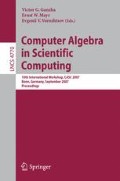Abstract
During the past decade, quantum information theory has attracted a lot of interest because of its promise for solving problems that are intractable otherwise. Despite of the recent advancements in understanding the basic principles of quantum information systems, however, there are still a large number of difficulties to be resolved. One of the great challenges concerns for instance the decoherence in quantum systems and how entanglement is lost or transfered between the subsystems, if they are coupled to their enviroment. — To overcome these difficulties, several schemes for studying the decay of quantum states and their interaction with an environment have been developed during recent years, including a large variety of separability and entanglement measures, decoherence-free subspaces as well as (quantum) error correction codes.
To support the investigation of entanglement and decoherence phenomena in general N −qubit quantum systems, we recently developed the Feynman program [1], a computer-algebraic approach within the framework of Maple, which facilitates the symbolic and numerical manipulation of quantum registers and quantum transformations. This program has been designed for studying the dynamics of quantum registers owing to their interaction with external fields and perturbations. In a recent addition to this program [2], moreover, we now implemented also various noise models as well as a number of entanglement measures (and related quantities). In this lecture, I shall display the interactive use of the program by a number of simple but intuitive examples.
To make quantum information theory alive, an active (re-) search has been initiated during the past decade to find and explore physical systems that are suitable to produce and control the entanglement in course of their time evolution. In atomic photoionization, for instance, we have shown how the polarization can be transfered from the incoming photons to the emitted photoelectrons, giving rise to a (spin-spin) entanglement between the photoelectron and the remaining (photo-) ion. Detailed computations on the entanglement as function of the energy and polarization of the incoming light have been carried out along various isoelectronic sequences [3]. For the two-photon decay of atomic hydrogen, moreover, we analyzed the geometrical control of the polarization entanglement of the emitted photons.
Access this chapter
Tax calculation will be finalised at checkout
Purchases are for personal use only
References
Radtke, T., Fritzsche, S.: Comput. Phys. Commun. 173, 91 (2006), ibid. 175, 145 (2005)
Radtke, T., Fritzsche, S.: Comput. Phys. Commun. 176, 617 (2007)
Radtke, T., Fritzsche, S., Surzhykov, A.: Phys. Lett. A 347, 73 (2005), Phys. Rev. A74, 032709 (2005)
Author information
Authors and Affiliations
Editor information
Rights and permissions
Copyright information
© 2007 Springer-Verlag Berlin Heidelberg
About this paper
Cite this paper
Fritzsche, S. (2007). Computer Algebra: A ‘Classical’ Path to Explore Decoherence and Entanglement Phenomena in Quantum Information Theory. In: Ganzha, V.G., Mayr, E.W., Vorozhtsov, E.V. (eds) Computer Algebra in Scientific Computing. CASC 2007. Lecture Notes in Computer Science, vol 4770. Springer, Berlin, Heidelberg. https://doi.org/10.1007/978-3-540-75187-8_11
Download citation
DOI: https://doi.org/10.1007/978-3-540-75187-8_11
Publisher Name: Springer, Berlin, Heidelberg
Print ISBN: 978-3-540-75186-1
Online ISBN: 978-3-540-75187-8
eBook Packages: Computer ScienceComputer Science (R0)

